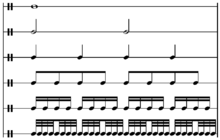Half note


In music, a half note (American) or minim (British) is a note played for half the duration of a whole note (or semibreve) and twice the duration of a quarter note (or crotchet). It was given its Latin name (minim, meaning "least or smallest") because it was the shortest of the five note values used in early medieval music notation (Morehen and Rastall 2001). In time signatures with 4 as the bottom number, such as 4/4 or 3/4 time, the half note is two beats long. However, when 2 is the bottom number (including alla breve), the half note is one beat long.
Half notes are notated with a hollow oval note head (like a whole note) and a straight note stem with no flags (like a quarter note; see Figure 1). The half rest (or minim rest) denotes a silence for the same duration. Half rests are drawn as filled-in rectangles sitting on top of the middle line of the musical staff. As with all notes with stems, half notes are drawn with stems to the right of the note head, facing up, when they are below the middle line of the staff (on or below the middle line for vocal notation). When they are on or above the middle line (or for vocal notation, just when they are above this line), they are drawn with stems on the left of the note head, facing down.
The American term half note is a 19th-century loan translation of German halbe Note.
The names of this note (and rest) in other languages vary:
| Language | note name | rest name |
|---|---|---|
| Arabic | البيضاء | سكتة البيضاء |
| Catalan | blanca | silenci de blanca |
| Chinese | 二分音符 (pinyin: èrfēn yīnfú) | 二分休止符 (pinyin: èrfēn xiūzhǐfú) |
| Czech | půlová nota | půlová pauza |
| Danish | halvnode | halvnodepause |
| Dutch | halve noot | halve rust |
| Esperanto | duona noto | duona paŭzo |
| French | blanche | demi-pause |
| German | halbe Note | halbe Pause |
| Greek | imisi/miso (ήμισι/μισό) | pafsi imiseos/pafsi misou (παύση ημίσεος/παύση μισού) |
| Italian | minima | pausa di minima |
| Japanese | 2分音符 (nibun onpu) | 2分休符 (nibun kyūfu) |
| Korean | 2분음표(二分音標 ibun eumpyo) | 2분쉼표(二分-標 ibun swimpyo) |
| Norwegian | halvnote | halvpause |
| Persian | سفید | سکوت سفید |
| Polish | półnuta | pauza półnutowa |
| Portuguese | mínima | pausa de mínima |
| Russian | половинная нота | половинная пауза |
| Serbian | polovin(k)a / половин(к)а | polovinska pauza / половинска пауза |
| Spanish | blanca | silencio de blanca |
| Swedish | halvnot | halvnotspaus / halvpaus |
| Thai | โน๊ตตัวขาว | ตัวหยุดตัวขาว |
The Catalan, French and Spanish names for the note (all meaning "white") derive from the fact that the minima was the shortest unfilled note in mensural white notation, which is true as well of the modern form. The form in the earlier black notation resembles the modern quarter note (crotchet). The Greek, Chinese, Japanese and Korean names mean "half" and in Greek, both the modern word (miso – μισό) and the older (imisi – ήμισι) are used. For the rest, the word "pafsi" (παύση) is used; this means "pause".
See also
References
- Morehen, John, and Richard Rastall. 2001. "Minim". The New Grove Dictionary of Music and Musicians, second edition, edited by Stanley Sadie and John Tyrrell. London: Macmillan Publishers.